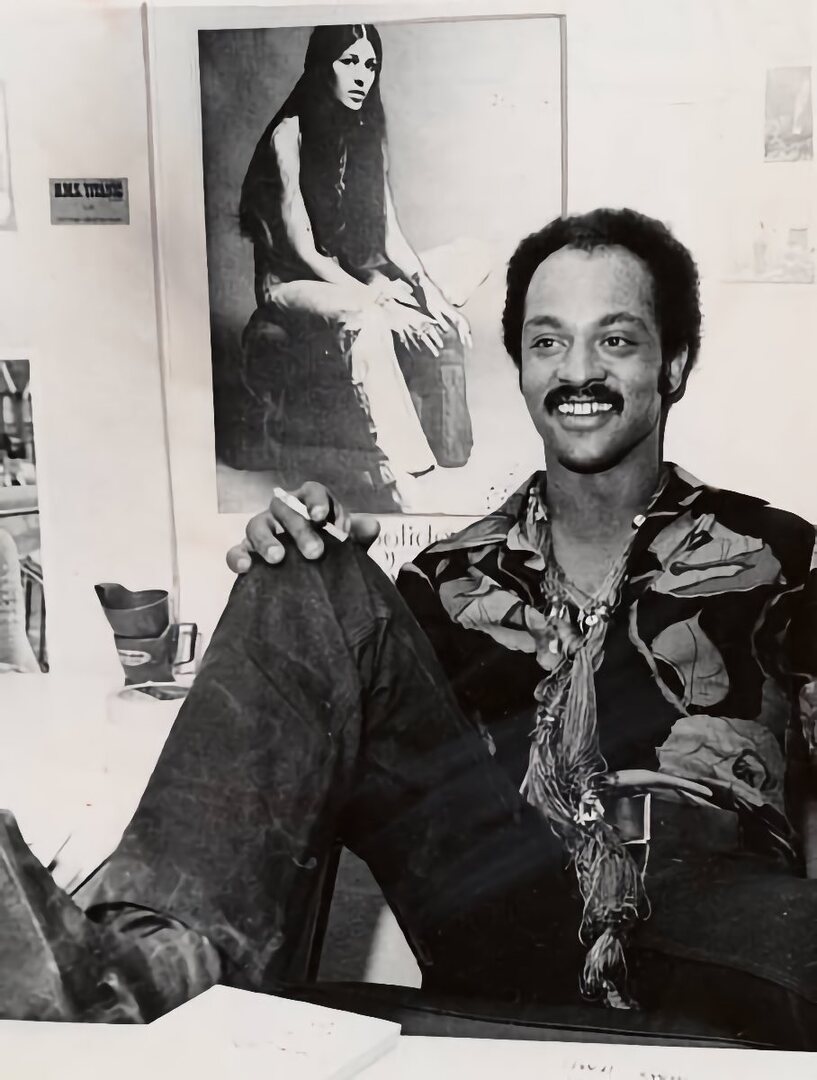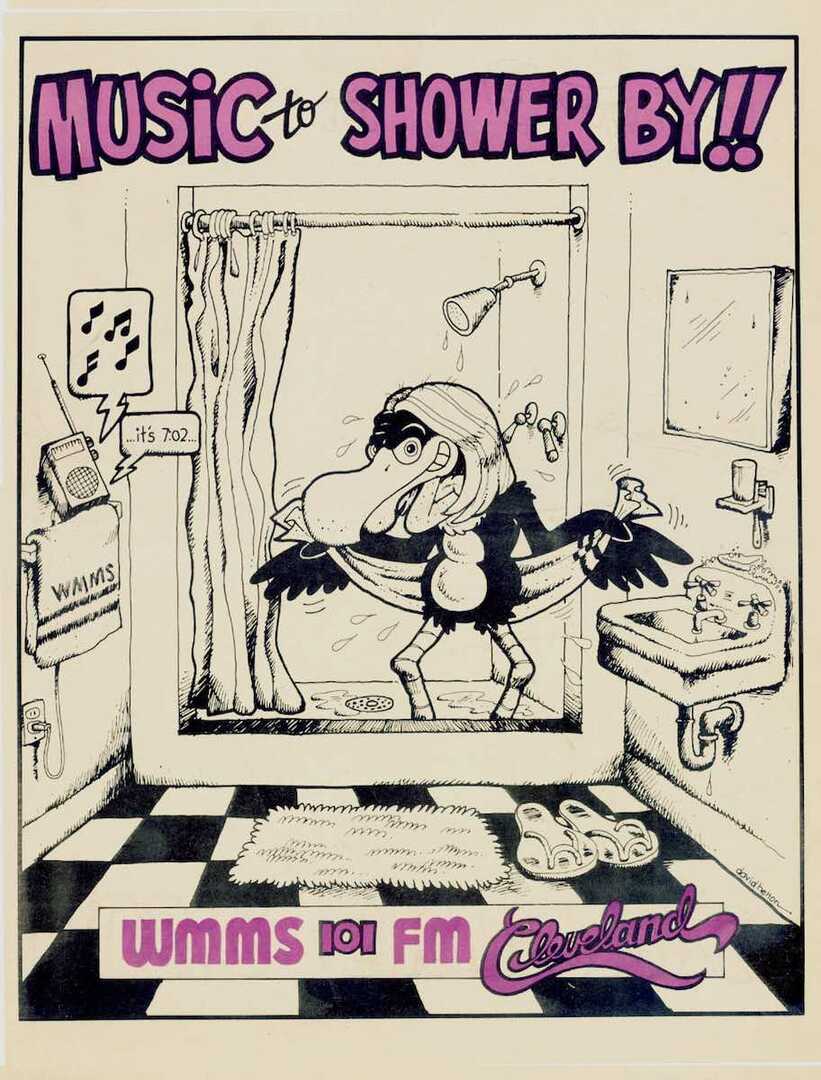
Youth culture writer Jane Scott noted, in an article for the Cleveland Plain Dealer, a handwritten sign hung in the broadcast booth at the first WMMS office that read, “Never play three electric tunes in a row. Never play three acoustic tunes in a row. Be real. Be good. Have fun. Be tight!” The sign was penned by Billy Bass, one of the first disc jockeys employed by the station. The article, published in early 1972, provided a glimpse into the mindset driving one of Cleveland’s newest cultural phenomena. WMMS was, at the time, an underground, progressive-rock radio station gaining traction among the city’s youth for its unique catalog and culture-savvy deejays, who were boldly airing music that reflected the period’s anti-war, anti-establishment, and anti-conservative sentiments. The station would continue to grow, and would later be responsible for breaking such acts as David Bowie, Rush, and Bruce Springsteen. Bass, and the rest of the WMMS crew, would revolutionize the radio industry – and mark Cleveland as the “Rock and Roll Capital of the World.”
Rock and roll, as a genre, was not born in Cleveland. But the genre was forever linked to the city when Cleveland deejay Alan Freed coined the term for the rhythm-and-blues records he was playing on his radio show for WJW-AM. Following his Moondog Coronation Ball in 1952, regarded as the first rock ‘n’ roll concert, the city was flooded with bars and clubs boasting live music, attracting the coming-of-age Baby Boomer population, and creating a prevalent youth culture within the city. In August of 1968, local AM station WHK debuted its first FM sister-station under the name WHK-FM. A few weeks later, the call letters were changed to WMMS. This new station became the first in Cleveland to feature full-time progressive rock programming.
The crew solidified their format in the early 1970s, officially becoming an album-oriented rock station and challenging the standards of radio broadcasting. They began airing “Coffeebreak Concerts,” mid-afternoon acoustic performances from popular local, national, and international artists, free for all listeners. They played songs that, subliminally or overtly, criticized war or politics. They quickly gained a loyal following of young rockers who, bored of their declining Midwest city and empowered by the student, feminist, and civil rights movements of the previous decade, were finally seeing themselves embodied in public media. The mid-’70s saw the debut of several on-air acts who would become household names in Cleveland, including Matt “the Cat” Lapczynski, later host of the Coffeebreak Concerts, Lawrence “Kid Leo” Travagliante, afternoon-drive host, late-night rocker Betty “Crash” Korvan, and Jeff Kinzbach and Ed Ferenc, cohosts of the “Buzzard Morning Zoo,” also known as “Jeff and Flash.”
The bizarre, irreverent antics of these deejays became a source of power for WMMS and were reflected in multiple aspects of the station’s programming and persona. The station ran PSAs promoting safe abortion services, much to the dismay of local conservatives. When corporate management insisted that they run more commercials, deejays discreetly fought back by playing humorous sound effects over the ads. Outside of the studio, WMMS staff made appearances at local events such as sponsored concerts and community gatherings, including a rally at nearby Cleveland State University advocating for youth voices and participation in government.
The station’s mascot itself exemplified their cheeky brand of humor. After a failed run of advertisements featuring the call letters as signifiers of the phrase “Where Music Means Something,” orchestrated by corporate leaders (leading some locals to adopt instead the phrase “Weed Makes Me Smile”), WMMS personnel took the reins and employed an artist to create an official logo. This artist, Jane Tiburski Elliot, drew a logo featuring a large mushroom shading a blissful-eyed alien as he smokes a joint. This, however, obviously did little to negate the claims that WMMS promoted drug use and it was dropped by management in 1974. Again, the station needed something new. As the story goes, program director John Gorman was driving home through the east side of Cleveland one night contemplating his work and its role within the city when he was struck by the first idea for what would become the buzzard. He describes it in his memoir as “A bird of doom for a dying city whose centerpiece was a crumbling building with the name ‘Terminal Tower.’” Gorman employed American Greetings card illustrator David Helton to create what is now one of the most recognizable mascots in rock radio history. With a sly grin, a mane of blond hair, and his common accessories of guitars and mushrooms, the Buzzard became the face not only of WMMS, but of Cleveland. The figure would later be printed on merchandise of all kinds – apparel, keychains, stickers, and so on – and stood as a symbol of the city’s perseverance.
In the station’s glory days, generally considered to be the mid-’70s through the late 1980s, it enjoyed soaring ratings. Music director and deejay Denny Sanders claims that of the 1.7 million people living in the Cleveland metropolitan area at the time, around 700,000 of them were WMMS listeners. Outside of Northeast Ohio, WMMS gained national recognition. It won the Rolling Stone magazine nationwide readers’ poll for “Best Radio Station” nine years in a row. Wall Street Journal writer Robert Werner noted in a 1979 article that “The primal energy of hard rock and roll apparently captures and abounds here [in Cleveland] more effectively,” largely due to the influence of WMMS. In the 1980s, it was WMMS deejays leading the lobby for the newly-conceived Rock and Roll Hall of Fame to be built in Cleveland, promoting on-air and to any Rock Hall board members that would listen that Cleveland was really the rock and roll capital of the world (a nickname coined years before by deejay Billy Bass), and in the late ’80s, the Rock Hall was constructed on the shores of Lake Erie.
WMMS, however, saw a period of decline in the 1990s, in both popularity and credibility. Increasing corporate oversight led to format changes and employee turnover as a few of the station’s most recognizable names, including Gorman, Sanders, “Kid Leo,” and “Jeff and Flash” departed. A Cleveland Plain Dealer article published in 1988 exposed an in-office memo addressed to staff from upper-management demanding they fill out hundreds of Rolling Stone poll ballots, leading to local outrage and a loss of national respect. The station is still in operation today, though new management has moved away from much of the station’s classic branding.
Though WMMS never quite recovered from corporatization or scandal, the legend of WMMS remains. The WMMS of the ’70s and ’80s revolutionized radio. The WMMS of the ’70s and ’80s gave a new, heartfelt nickname to a city once commonly referred to as “the mistake by the lake.” The WMMS of the ’70s and ’80s was progressive, was loud and obnoxious, was obscene, and was one-of-a-kind. But the WMMS of the ’70s and ’80s had to come to an end. “Kid Leo” was quoted in a Cleveland Plain Dealer article in 1989 saying, “We were a family that lived, worked, and played together… The station was like a family dinner table that went on 24 hours a day.” That same article quotes John Gorman: “These kinds of utopias don’t last.” It’s true – WMMS did not, in essence, last – but its influence on the culture of Cleveland is everlasting.
Audio
Images







